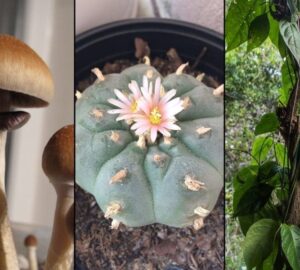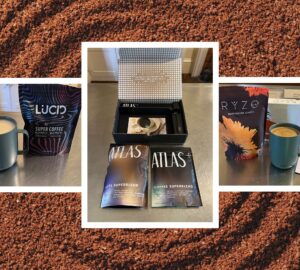Mushroom fruiting chambers take on a number of different forms, but their purpose remains the same: to provide an isolated and controlled environment that provides optimal conditions for mushroom growth. These conditions will vary with species, with each having its own particular temperature, humidity, and fresh air requirements.
The type of fruiting chamber you select will be dictated by the fungal species you are fruiting. Some species such as Psilocybe cubensis aren’t particularly fussy, and while they appreciate a humid environment, their fresh air exchange requirements are lower than other species. Other species, such as Panaeolus cyanescens, Psilocybe tampanensis, P. ochraceocentrata and some of the Psilocybe species held in high shamanic regard in Mexico—which are attracting increasing cultivator interest such as P. caerulescens,P. mexicana, P. subtropicalis and P. zapotecorum—all have higher fresh air requirements during fruiting (with the need to also maintain high humidity levels). All the fruiting chamber setups discussed here (apart from the Martha greenhouse) make use of large, transparent plastic tubs that are customized in a number of ways. The fruiting chamber setups that will be discussed include:
The Monotub The Diffuser Tub The Dubtub The Dunk Dubtub The Shotgun Fruiting Chamber (SGFC) The Martha Greenhouse
The Monotub
The monotub is a highly effective fruiting chamber that provides a cheap, simple, and low maintenance means of growing mushrooms, well suited to beginner cultivators, providing a largely ‘set and forget’ approach to fruiting. They are ideal for bulk grows, capable of producing bountiful yields of mushrooms, and are inexpensive and easy to set up. They are versatile and easily scalable, while being fairly compact and space efficient, making them well suited to home cultivation. The monotub is designed to allow internal humidity and gas levels to remain optimal with only minor adjustments required over the duration of the grow.
The monotub is geared towards fruiting with bulk substrate, ideal for bulk grows of P. cubensis. Some growers have also successfully fruited P. ochraceocentrata in monotubs (although they may take on a more ‘noodly’ form). Others have reported better results with a setup that provides higher levels of fresh air exchange. Some cultivators have reported better results with uniform fresh air exchange, facilitated by balancing the lid on the upturned handles of the tub when fruiting P. ochraceocentrata.
A monotub is made from a large transparent plastic tub with a transparent lid. A tub that holds 50-70 litres (53-74 qt) is a good size, allowing ample space for good yields while remaining light enough to be easily handled. Stackable tubs allow for easy storage and scaling of the grow operation. Bulk substrate tends to be used in monotubs (such as a mix of manure, coir and vermiculite), which is colonized by mycelium through being mixed with colonized grain.
Holes are made strategically in the side of the tub to facilitate the movement of gases and air, allowing the mycelium to breathe without drying out the substrate. Six fresh air exchange (FAE) holes can be made, with two holes made along each of the long sides of the tub, and one along each of the short sides. The base of each hole on the long side of the tub should be 9-10 cm (3.5-4 in) from the bottom of the tub, while the holes on the short side of the tub should be positioned centrally and high up, close to the lid. To begin with, these holes should be taped up to ensure high humidity levels.
Once the bulk substrate is fully colonized, fruiting conditions can be initiated, and the tape removed and holes stuffed with synthetic cushion filler (Poly-Fil) or micropore tape. If using cushion filler material, the top holes can be packed more loosely with less material than the bottom holes in the tub. This will allow for greater airflow and more gas exchange and evaporation from the surface of the substrate, while helping retain humidity levels. During fruiting conditions, supplemental air exchange via fanning (with the tub lid) and lightly misting the inside walls of the tub to maintain high humidity levels will be required 2-3 times a day.
As the mushrooms grow they will produce carbon dioxide, which in excess levels can impede fruiting. Carbon dioxide is heavier than air, so positioning holes lower down, a few inches above the bottom of the tub, will help prevent it from building up. Holes can be marked out on the side of the tub with a permanent marker and something like a drill with a 5 cm (2 inch) hole cutter fitting used to cut them out. Do not apply too much pressure with the drill or you risk cracking the plastic. Mushrooms will grow towards light, so some growers apply black spray paint or black electrical tape to block light, or instead line the bottom of the tab with an opaque plastic bag or liner to help ensure consistent vertical growth of the mushrooms. The monotub is now complete and ready for use.
The Diffuser Tub
A variation on the monotub design for fruiting, diffuser tubs make use of the same large clear plastic tubs, but use a different setup configuration to enhance humidity and fresh air exchange. A 60-75 litre tub can work well. Diffuser tub setups have been used to successfully fruit a range of species, including those held in high shamanic esteem in Mexico including P. caerulescens, P. mexicana, P. subtropicalis and P. zapotecorum, in addition to other species such as P. ochraceocentrata, P. tampanensis, and Panaeolus cyanescens (although a heat source will likely be necessary if fruiting the latter). There are two variations on the diffuser tub design:
One with a layer of wet perlite in the base, with two jars of water. The jars of water alone when combined with perlite will ensure high humidity levels through passive evaporation, but some growers recommend adding an aquarium air pump (with multiple air hoses), fitting air stones to the air hoses, and adding them to the jars. The jars should have a lid, with a hole drilled to allow air hose access, and smaller holes drilled in the rest of the lid (salt shaker style). Otherwise the bubbling of the aerated water in the open jars will result in oversaturation of your fruiting trays. This aeration from the air pump serves to elevate both the fresh air flow and humidity levels at the same time, to the benefit of fruiting mushrooms. In one variation of this diffuser tub setup—the ‘Shadowbox’—water is instead added directly to the perlite in the base of the tub, and the air hoses and stones are positioned within this. Alternatively, an inch of tap water can be used in the base of the tub instead of perlite, and the air hoses and accompanying air stones submerged directly into this water (long diffuser air stones may be optimal). The fruiting trays sit on a wire rack above the water. This variation of the diffuser tub design is also referred to as a “JCM bubbler fruiting chamber.” Change the water once a week (water will absorb carbon dioxide produced by the fruiting culture, converting it to carbonic acid). Before pins appear, keep the lids on (higher humidity and carbon dioxide is fine prior to primordia formation) and add the air pumps once pins appear. Crack and flip the lid to allow for a little more air exchange once these first pins appear. The addition of a fogger (on a timer) may benefit the fruiting of species such as P. zapotecorum (although it may not be necessary). This can potentially be used with a humidity sensor that kicks the fogger on once the humidity falls to a certain level. Submersible, dimmable aquarium lights can also potentially be added to this setup. Aquarium heaters can potentially be used when fruiting warm weather mushrooms, and aquarium chillers for fruiting cold weather species.
The Dubtub
The dubtub is another low maintenance setup, a tweak on the monotub fruiting setup where one tub is inverted and placed on another identical tub (hence the “dub” or double tub). This provides more vertical space in the fruiting chamber which suits taller growing varieties of mushroom, while containing more air than a regular monotub, providing a more stable growing environment. Dubtubs can be variable in size, depending on the needs of the cultivator (smaller tubs can be useful for exploring genetics and unique properties of P. cubensis). Similar to a monotub, a dubtub features holes on the sides filled with pillow stuffing or micropore tape, and it is also well suited to bulk substrate cultivation. It shares the same benefits of monotubs with regard to its scalability and low maintenance needs.
There should be four holes in each tub, two on each of the long sides (with less holes needed in smaller tubs). In the bottom tub, holes should be positioned so they will be close to the top of the substrate, which will help facilitate removal of carbon dioxide which can impede fruiting. The holes in the top tub, which forms the humidity dome, can be made at the same height as in the bottom tub, allowing them to be used interchangeably.
Some growers use duct tape to tape up the intersection where one tub rests atop the other. Later, this tape can be removed, while leaving one strip of tape along one of the long sides of the tubs. This creates a clam shell effect where the tubs can be opened to easily access the inside while keeping the tubs aligned. You will need to fan and mist three times a day minimum during fruiting.
The Dunk Dubtub
Similar to the classical dubtub outlined above, the dunk dubtub (DDT) also makes use of two tubs, but in a very different manner, with one tub sitting in the other, which contains heated water. This approach is specifically geared towards fruiting Panaeolus cyanescens, having been shared by experienced grower GordoTEK, in the hope of making the cultivation of this species easier for people (it being considered more challenging to grow than P. cubensis, while commonly being more highly revered by psilonauts). This approach is designed to meet the temperature, humidity, and fresh air requirements of this species, while being able to dispense with equipment such as humidifiers, fans, timers and tents sometimes recommended for fruiting them. This setup also works well for fruiting P. ochraceocentrata, although this species has lower fresh air exchange requirements than Panaeolus cyanescens.
Shallow clear tubs or storage boxes (the kind designed to fit under a bed) are ideal; a range of sizes can be used but 39 litre (41 Quart) tub size works well, and you will need two of the exact same size. One of the tubs is filled half way, and an aquarium heater introduced to the bottom set to 82F (28C). Testing the water temperature to ensure that it is in the low 80’s, colonized grain is mixed with bulk substrate, which is then left to fully colonize for 6-8 days. Once colonized, a casing layer should be applied and fruiting conditions can be initiated, and a fine gauze window screen mesh be used in place of the lid.
The casing layer and both sides of the window screen should be sprayed with water (ideally three times a day) to ensure the casing layer doesn’t dry out. The lid of the tub can be sprayed with water on its underside and placed atop the window screen, but at an angle so the two corners of the fruiting tub are exposed to the air. Each time water is sprayed, the lid placement can be alternated, so the opposite corners of the fruiting tub are open. A little water can be added between any gaps forming between the substrate and the sides of the tub in order to rehydrate it, and about a half cup of water can be poured slowly and evenly across the substrate surface after a flush is harvested.
The Shotgun Fruiting Chamber
The shotgun fruiting chamber (SGFC) is well suited to small scale grows (using methods such as PF Tek) and species requiring consistent high humidity when fruiting. It is inexpensive and simple to modify a clear plastic tub using a few basic tools and materials. The ‘shotgun’ in its name is in reference to the many small holes in the fruiting chamber tub (with holes – usually 0.25 inch (0.6 cm) – drilled on all sides), which facilitates passive air exchange. A depth of two inches of perlite is added to the base of the SGFC and moistened to maintain humidity. SGFC’s are well suited for small scale grows, and fruiting ready rice bags, grow bags and kits, substrate blocks, small trays and the brown rice flour cakes associated with the ‘PF Tek’ approach of growing P. cubensis. Growers have also reported success fruiting other species such as oyster mushrooms and lion’s mane in SGFC’s. However SGFC’s are not well suited for larger grows using bulk substrate.
Some growers recommend using a 66 quart plastic tub, while others have used tubs in the range of 60-80 litres for creating a SGFC. Holes are drilled in a grid like pattern two inches apart (using a tape measure) on all six sides of the tub, including the top and bottom (holes can be marked out with permanent marker before drilling). A cone shaped drill bit can be helpful when drilling into plastic. A knife or scalpel can be used to remove the excess plastic from drilling the holes. These holes aren’t covered at any point, unlike when fruiting mushrooms with a monotub or dubtub.
Add the perlite to the SGFC, soaking it for a few minutes and allowing it to drain through the bottom. The base of the SGFC should be elevated (sitting it or the four corners of it on a wire rack or stands) to help facilitate airflow through the base of the tub, in addition to the sides. Fruiting blocks can create their own microclimate in the tubs, with the growing mushrooms creating warmth as they grow; warmer air rises in the tubs, drawing in cooler, moister air through the perlite, ensuring high humidity and air exchange in the SGFC.
Source the coarser, larger participle sized perlite as this will help the SGFC breathe. Add 3-4 inches of perlite; a deeper layer will provide a greater reservoir of water and therefore, humidity. However, the level of the perlite should not be above the lowest row of holes on the tub so as not to impede air flow at surface level of the perlite which can act as a pinning trigger. Perlite provides a biologically inert substrate that acts as an airy water store. Some growers recommend drilling smaller 6mm holes in the base to better help retain the perlite. The perlite should be cleaned by rinsing in water at monthly intervals (or after a mold outbreak). The sides of the SGFC can be wiped with 70% isopropyl alcohol between removing and adding more fruiting bags, cakes or trays.
The Martha Greenhouse
The ‘Martha’ greenhouse usually comprises a small four-tier greenhouse covered in a non-porous cover (typically reinforced plastic) and a zip up curtain through which you can access the inside. Its name was inspired by a Martha Stewart portable closet, to which it bears a resemblance. It is a setup accommodating larger scale grows, and allows for automation and heightened customization and control over the environment, making it possible to finetune the fruiting needs for a range of different mushroom species. It can provide a largely automated fruiting environment that can support large-scale production of mushrooms, although its slightly more intricate setup in comparison to the other fruiting chambers may make it better suited for more experienced growers. In addition it takes up more vertical space than the other types of fruiting chamber discussed previously.
It is well suited for species that prefer high humidity and high levels of fresh air exchange during fruiting, working best for fruiting substrates that are already fully colonised. Given the fine tuning of environmental conditions possible with a Martha greenhouse, all the psilocybin mushroom species mentioned previously can be successfully fruited in one. In addition to psilocybin mushroom species, a range of gourmet and medicinal mushrooms have been successfully fruited in Martha greenhouses, including reishi, oyster, chestnut, lion’s mane, pioppino, shiitake, maitake and enoki mushrooms.
The greenhouse can be refined in a number of ways depending on the temperature, humidity, and fresh air requirements of the given mushroom species being fruited. Some growers recommend placing a heat mat and/or a submersible aquarium heater in a tub of water in the base of the greenhouse if warmer temperatures are needed (the submerged aquarium heater will also elevate humidity). A fan can potentially be installed in the greenhouse (near the top of the greenhouse, where it is less likely to blow in contaminants in comparison to floor level) to facilitate fresh air exchange, and an ultrasonic humidifier placed in the greenhouse, or an external fogger piping in water vapour can be used to raise the humidity. These can either be plugged into timers, or a humidity and temperature controller to switch them on as and when needed, allowing for customization of humidity and fresh air exchange, depending on the requirements of the species being fruited. A drip tray should be placed underneath the greenhouse to catch drips of condensation.
DoubleBlind Mag Read More




